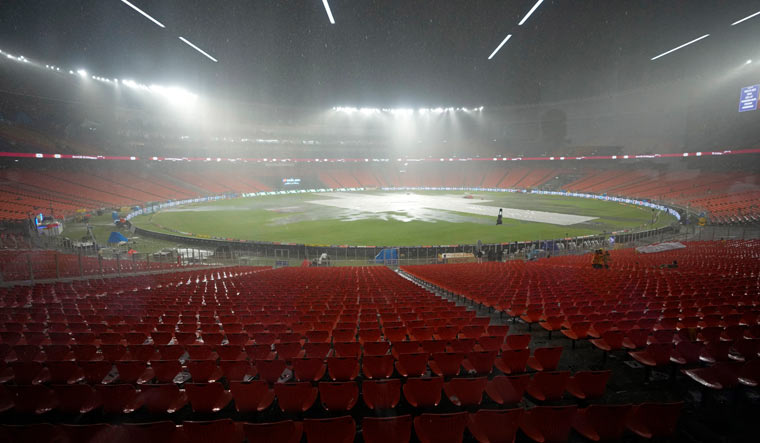With state-of-the-art facilities, the Narendra Modi Stadium in Ahmedabad with a seating capacity of 1.32 lakh was an obvious choice for the grand finale of IPL 2023. The world’s largest cricket stadium was all geared up to host defending champions Gujarat Titans and M.S. Dhoni-led Chennai Super Kings on May 28.
From the very morning, fans started converging in Ahmedabad from all over Gujarat and even from different parts of the country. However, the rain God had thought something different. Just before the toss, it started raining badly. The hailstorm continued for a couple of hours and the match was shifted to the reserve day on May 29. Here too, the rains hampered the play and the CSK emerged the winner on the basis of DL system.
Post the match, along with the pictures, speeches, posts and videos of Dhoni, Ravindra Jadeja and Hardik Patel, one more thing that went viral on social media—water flowing at a full speed from the stairs of the stadium, leaking roofs and ground staff using sponges and hair dryers to dry the area near the wicket.
The videos were shared apparently by spectators at the stadium. However, it gave an opportunity for the political opponents to "york" the BJP. After all, none less than Prime Minister Narendra Modi and Union Home Minister Amit Shah have occupied the president’s post in the Gujarat Cricket Association.
The Trinamool Congress shared an old video of Shah explaining the salient features of the stadium and the ground. It then went on to show the leaking roofs, water running down from the stairs and groundsmen struggling to dry the area, especially near the wicket.
The area near Motera, where the stadium is located, received over 70 mm rainfall in two hours.
It was a moment of embarrassment for both the GCA and the BCCI. The stadium, envisaged by none other than PM Modi, was built at an estimated cost of Rs 800 crore and, according to sources, its annual maintenance comes to about Rs 2 crore.
Before the inauguration, there were reports that the stadium was designed in such a way that a match could be played in about 45 minutes after the rain stopped.
However, GCA president Dhanraj Nathwani has a different take. He told THE WEEK that despite the rain on the actual day of the final, the stadium was readied to host the match on the second day and accommodate one lakh people.
The play area, according to him, is designed with an effective sub-surface drainage system that can clear up to 150 mm rain water per hour. There was no water logging in the field area, he said.
He said the stadium is an outdoor facility and prone to weather effects on its structures on a regular basis. Hence, construction and expansion joints tend to be open. This, he said, leads to water seeping through. Once such openings are found after the first rains, the rectification takes place, he added.
Nathwani denied that there was any water logging on the 360 degree podium concourse where most of the spectators took shelter and waited for the rains to stop. The rain water in the non-spectator area goes to the storm water drain at the ground level, he added.
The GCA president pointed out that none of the players slipped during the course of the match.



